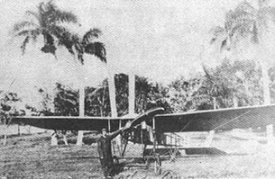

Cuban Aviators, III PartJuan Luis Silva Tablada, Arnaldo Tamayo Méndez, Mario Torres MenierRuben Urribarres |
Colonel. Veteran of Bay of Pigs, one of the FAR´s founders
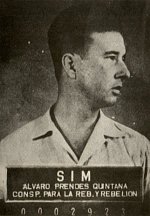 He
was born 1928 in Guantánamo. After the College, in 1950 he enters to the
Army Infantry School, and to the Recruits School of the FAEC. In May of 1953 arrives
to US to a jet pilot training. He is graduates in August of 1954. Begins to serve
in the FAEC as Lieutenant and pilot of the F-47D Thunderbolt Squadron,
of in one of which suffers an accident in 1955. That year he returns to
US to complete a two months course of flights by instruments in F-86. Begins to
conspire against Batista as member of the Movement "26 of July" of Fidel Castro
inside the Air Force, where he recruits Carreras.
During the revolt of the Navy in Cienfuegos
the September 5, 1957, Prendes impedes that the F-47D bombing the Cayo Loco Naval
Base. By this action, is arrested the 6 of September. The military court condemns
it to death, then the grief is reduced to 6 years of jail and remains in prison
until the triumph of the revolution on January 1, 1959.
He
was born 1928 in Guantánamo. After the College, in 1950 he enters to the
Army Infantry School, and to the Recruits School of the FAEC. In May of 1953 arrives
to US to a jet pilot training. He is graduates in August of 1954. Begins to serve
in the FAEC as Lieutenant and pilot of the F-47D Thunderbolt Squadron,
of in one of which suffers an accident in 1955. That year he returns to
US to complete a two months course of flights by instruments in F-86. Begins to
conspire against Batista as member of the Movement "26 of July" of Fidel Castro
inside the Air Force, where he recruits Carreras.
During the revolt of the Navy in Cienfuegos
the September 5, 1957, Prendes impedes that the F-47D bombing the Cayo Loco Naval
Base. By this action, is arrested the 6 of September. The military court condemns
it to death, then the grief is reduced to 6 years of jail and remains in prison
until the triumph of the revolution on January 1, 1959. Since the first
days of the new government, he is opposed to the leader of the Air Force Diaz
Lanz, who expels it from the corp, but Raúl Castro supports Prendes, and
when Lanz deserts to US, Prendes returns to the aviation. Begin a course of training
in the T-33, and then passes to fly in the DC-3 of Cubana. He participates in
the ground combats in the Escambray mountains against the rebels. When beginning
the combats in Bay of Pigs on April 17, 1961, Prendes returns to
the Air Force. In the three days of the battle, does 14 combat missions (the pilot
that more flew). In its T-33 shoot down 3 airplanes B-26 of the
exiled, considerably contributing to the defeat of these. Is ascended to
Major, and receive the tittle of "Girón Hero".
 |
 |
 |
| | |
|
Prendes was the first Cuban pilot in flying the MiGs, when in November of 1960 he test in flight a MiG-15 in Czechoslovakia, during a secret mission of weapon purchase. When arriving the MiG-15bis in May of 1961, Prendes is one of the 6 chosen pilots to assimilate them, and is appointed as Second Leader of the first fighter Squadron MiG-15bis. During the Cuban Missile Crisis in October of 1962, is Leader of the San Antonio Air Base, the most important of the country. When the MiG-21 Fighter Regiment entering in service in 1963, he is appointed as his leader. In 1966 and 1968 he was trainned in the USSR. By 1973 he is First Commander, and Deputy Chief of foreign affairs in the Armed Forces Ministry. In 1974 he goes to Angola as one of the first pilot send there, where he was injured, and also to the South Yemen. Professor of the University of Havana.
Prendes several times was destitute from its charges and degraded by problems of service and by differences with its superiors. For 1992 these differences were deep. In July of 1993 their children treat fruitlessly of fleeing from Cuba in a boat, and in September its daughter Djamila Prendes asks political asylum in Spain. In 1994 the U.S. Department of State give him a visa as politic refuge, and he leaves the country. Already in Miami he creates the "Unión de Soldados y Oficiales Libres" (Free Soldiers and Officer Union, (USOL), that united exiled FAR ex-military. He publishes the books "En el punto rojo de mi colimador" (In the red point of my colimador, 1973, MINFAR prize), "Piloto de guerra" (War Pilot, 1982, prize of the literary critics), "Prólogo para una batalla" (Prologue for a battle, (1988). In 1998 after the exiled critics, he publishes the article: "Me equivoqué de bando pero lo he pagado" (I mistook of side, but I have paid this).
![]() Domingo Rosillo del Toro
Domingo Rosillo del Toro
Pioneer
of the Cuban Aviation 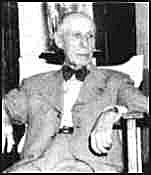 Though
a Cuban citizen, Rosillo was born at Oran, Algeria, in 1878 in a spanish family,
and soloed on a Morane-Saulnier at Villacoublayin Oran. He sports an Aero Club
de France FAI certificate dated October 22, 1912, being the first in obtaining
a license of the International Aviation Federation. In March 31, 1913 Rosillo
performs one of the first flights over Havana. In May 17, 1913 Rosillo, considered
as one of the more famous pilots of its epoque, wrote its name in the history
of the aviacion, when made the first international flight of the aviation in
Latin America, establishing a world record of distance when flying
in its Bleriot XI the 90 miles since Key West to Havana in 2 hours and 40 minutes,
a Flight of Audacious.
Though
a Cuban citizen, Rosillo was born at Oran, Algeria, in 1878 in a spanish family,
and soloed on a Morane-Saulnier at Villacoublayin Oran. He sports an Aero Club
de France FAI certificate dated October 22, 1912, being the first in obtaining
a license of the International Aviation Federation. In March 31, 1913 Rosillo
performs one of the first flights over Havana. In May 17, 1913 Rosillo, considered
as one of the more famous pilots of its epoque, wrote its name in the history
of the aviacion, when made the first international flight of the aviation in
Latin America, establishing a world record of distance when flying
in its Bleriot XI the 90 miles since Key West to Havana in 2 hours and 40 minutes,
a Flight of Audacious.
This record was snatched nothing less than to the famous french pilot and aeronautical designer Luis Bleriot (22 miles to cross the Canal of La Manche). With this flight he earns a prize of $ 10 000 by being the first pilot in crossing that route. With Rosillo competed in that flight Agustín Parlá,, that cross the strait two days after.
He was recognized then as Capitan in the Cubans Armed Forces. In February 25, 1914 Rosillo flies since Pinar del Rio, the western of the Island of Cuba, to Havana, Cuba, first flight in that direccion. In 1916 he travels to Barcelona, Spain, where works as flight instructor in the Aviation School situated in the airport "La Volateria" ("El Prat"), of the firm 'Pujol, Comabella and Cia', that work for the city hall of Barcelona. In 1917 he is appointed Director of that School, and in 1919 test pilot of the construction firm of airplanes of that city. He was the winner of various competition flights. Rosillo returns to Cuba in 1937, where went during many years the Secretary of the National Academy of Civil Aviation and Air Reserves (ANACRA). He receive the more high condecorations of Cuba. Rosillo dies retired in Havana at November 28, 1957. Its image today appears in the Jewel of the National Order to the Merite of the Civil Aviacion of the Republica of Cuba.
![]() Luis Alfonso Silva Tablada
Luis Alfonso Silva Tablada
First
combat pilot of the Castro´s rebels. Fallen in Bay of Pigs 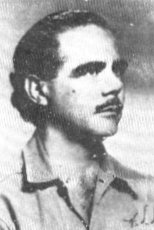 Silva
Tablada graduates in the pilot promotion pilots of the Air Corp in 1941. During
the Second World War he patroled the Cuban water in search of Germans submarines.
After the Batista's coup d'etat Silva conspires and was imprisoned. He joins with
the Movement "26 of July" of Fidel Castro. In November 13, 1958 he flew from Miami
to the Sierra Cristal, in a Cessna-180 with weapons for the rebelds of the Second
Front of Raul Castro, and since this forming part of the Fuerza
Aérea Rebelde
Silva
Tablada graduates in the pilot promotion pilots of the Air Corp in 1941. During
the Second World War he patroled the Cuban water in search of Germans submarines.
After the Batista's coup d'etat Silva conspires and was imprisoned. He joins with
the Movement "26 of July" of Fidel Castro. In November 13, 1958 he flew from Miami
to the Sierra Cristal, in a Cessna-180 with weapons for the rebelds of the Second
Front of Raul Castro, and since this forming part of the Fuerza
Aérea Rebelde
Its first combat action was the attack to the Army's
camp in La Maya, with 200 soldiers and that was circled by the rebels. November
7, 1958 at 5.30 o'clock the Vought OS2U-3 Kingfisher,
piloted by Silva Tablada and with the gunner Leonel Pajan, take off from Mayari
for the "Operacion A-001". He carried 2 demolition bombs. When the Kingfisher
arriving, the soldiers jump "the FAE, the FAE!", but Silva in three pass places
the two bombs in the center of the camp, and shoot him. The sichological impact
was such, that immediately the soldiers hoist white flag and they are yielded,
finalizing 14 days of fierce battles. With this victory were united the territories
of two rebels fronts and is controlled totally the highway Santiago - Guantanamo.
Another of the strategics points of the moment, was Sagua de Tanamo, where the
Army fought in the city hall. At December 19-20, 1958, Silva Tablada
in its Kingfisher attacks the headquarters three times, contributing to the fall
of the headquarters.
With the revolutionary triumph Silva Tablada was one of the pillars of the new Revolutionary Air Force. After the flight of Diaz Lanz, he is appointed as Squadron Leader of the bombers (B-26 Invader). When begin the combats at Bay of Pigs April 17, 1961, Silva Tablada was patient, but he is thrown to the battle. At 4.45 o'clock of the morning Fidel Castro calls him by phone to the San Antonio base, and he orders to attack the ships that disembarked troops. Then take off for its first missions two Sea Fury with Carreras and Bourzac, and the B-26 of Silva Tablada. They take off at 5.20 o'clock, and damaged the ship "Houston", the B-26 of Silva was damaged by the anti-aircraft fire of the ships. Silva later flew for second time in another B-26, to made its second and last mission of battle, in which dies. He tried to be approached in its B-26 to the ship "Blagar", in flight level over the waves of the sea, without evading the intense anti-aircraft fire, when an impact exploits the rockets under the B-26 wing, falling the B-26 to the sea, and striking with some pieces the ship. In their B-26 die too the navegant Alfredo Noa, the mechanic Reinaldo Gonzalez Galainea, and the gunner Marin Torres.
![]() Arnaldo Tamayo Méndez
Arnaldo Tamayo Méndez
Brigade
General. The First Latin American Cosmonaut 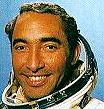 He
was born January 29, 1942 in Guantanamo. Being without parents, he begins to work
at the age of 13 years, as clean shoes and assistant of carpenter. After the revolucion
he enters in the Asociation of Young Rebels. He enters in the Technological Institute
"Rebel Army" and later in the Revolutionaries Armed Forces. In May of 1961 he
travels to the USSR to a pilot course for the MiG-15, and he returns graduated
an year later. During the Missile Crisis of October 1962, he did some twenty reccon
missions. In 1963 he was lieutenant, and in 1967 he was appointed as Squadron
leader, visit Vietnam and enters in the Communist Party. Since 1969 he studies
in the 'Maximo Gomez' Military Academy, that he finishes in 1971. In 1971-1975
he is head of Stab of one of the Brigades of Fighter Aviation. In 1975 he is Major
and deputy leader of the Aviation Brigade of Santa Clara. He is Pilot instructor
and has the category of first class since 1968. Was ascended to Lieutenant
Colonel in 1976, and in March of 1978 he travels to the USSR to be a training,
after he was elected for the cosmic program.
He
was born January 29, 1942 in Guantanamo. Being without parents, he begins to work
at the age of 13 years, as clean shoes and assistant of carpenter. After the revolucion
he enters in the Asociation of Young Rebels. He enters in the Technological Institute
"Rebel Army" and later in the Revolutionaries Armed Forces. In May of 1961 he
travels to the USSR to a pilot course for the MiG-15, and he returns graduated
an year later. During the Missile Crisis of October 1962, he did some twenty reccon
missions. In 1963 he was lieutenant, and in 1967 he was appointed as Squadron
leader, visit Vietnam and enters in the Communist Party. Since 1969 he studies
in the 'Maximo Gomez' Military Academy, that he finishes in 1971. In 1971-1975
he is head of Stab of one of the Brigades of Fighter Aviation. In 1975 he is Major
and deputy leader of the Aviation Brigade of Santa Clara. He is Pilot instructor
and has the category of first class since 1968. Was ascended to Lieutenant
Colonel in 1976, and in March of 1978 he travels to the USSR to be a training,
after he was elected for the cosmic program.
In September 18, 1980, the Lieutenant Colonel Tamayo take off to the cosmos accompanied by the soviet cosmonaut, Colonel Yuri Romanenko, in the spaceship Soyuz-38. They working a week in the orbital module Saliut-6 and after diverse experiments, they return to ground the September 26. In Moscou Leonid Brezhnev condecore it with the Lenin Order and the Gold Star of Soviet Union Hero. To its return to Cuba, he is received for Fidel and Raul Castro, that it condecored with the first medal of Hero of the Republic of Cuba. Since 1981 Tamayo directs the SEPMI (Society of Military and Patriotic Education), a paramilitary organization for the youth, and the Aviation Club of Cuba. Tamayo today is Brigade General and Chief of the section for foreign affairs of the FAR Minister. In 1967 he marries with Mayra Lobaina and he have two children.
![]() Mario Torres Menier
Mario Torres Menier
Captain
Pilot, one of the Cuban Aviation historical Leader
May
24, 1925 Towers is appointed for the President Gerardo Machado as leader
of the reorganizated Cuban Army Aviation Corp, participating in the grow and modernization
of the Corp. When To the Military Aviation School is re-open in March 5, 1928,
Torres Menier is one of his professors, attending the disciplines of Military
Courtesy, Service Rules, Maps, Anti-Aircraft Defense, and Reading of Air Photographs.
In 1931 the Capitan Torres Menier is Executive of the Air Corp. In September of
1932 he directs an Squadron of Vought Corsair that flies to Mexico to participate
in the nationals parties of the brother country. The September 10, 1933 he part
in flight of good will by various countries of Central America and south of the
United States, with the Lieutenants Pablo Alonso and Rodolfo Herrera, in his airplanes
Corsair. They return to Havana October 13, 1933.
The demand of Torres Menier to the President Machado so that abandoned the power, under the threat of using the military aviation against their, was one of the decisive moments in the 1933 Revolution. Machado was seen then obliged to resign and abandonment Cuba August 13, 1933. Little later, in September, came the Sergeants Revolution, as product of a conspiracy with the participation of some sergeants and soldiers. They asked to Torres Menier to form part, but he went to investigate the conspiracy. Menier said about this to Fulgencio Batista, one of the Sergeants that demand a better processing for the enlisted man. Batista went to the Columbia headquarters, and gained the troop, promoting him to revolved, leaving Menier in a secondary place. Since then Batista converted himself in the "strong man" of Cuba by decades.
In 1945 Torres Menier was the one Cuban that participates in the fundation of the International Civil Aviation Organization (OACI). That year he was member of the examination courts of the National Comission of Transportation, that offers civil pilot licenses. He forms part with Nicolas Mendoza, of the Cuban Delegation that signs October 2, 1947 the International Convention of Telecommunications. After the Revolution of 1959, Torres Menier is one of the leaders of the airline Cubana de Aviacion. He dies in Havana January 14, 1977.
|
|
|
|
|||

